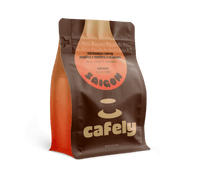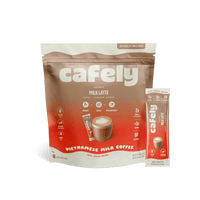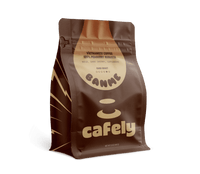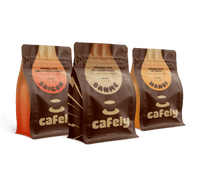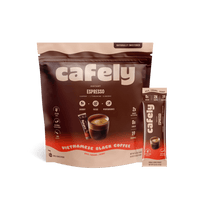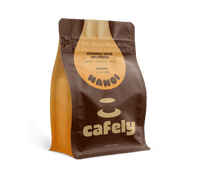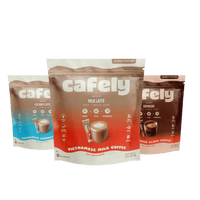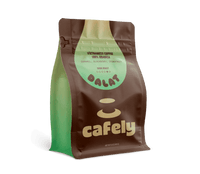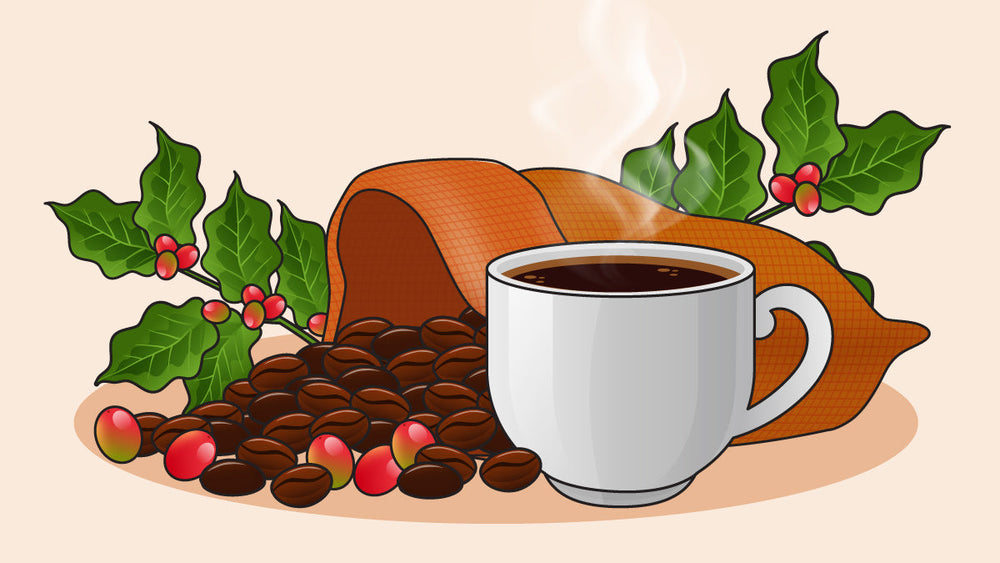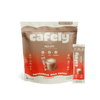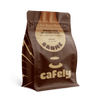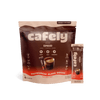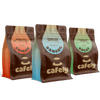Coffee is second to water as the most commonly consumed beverage in the US [11]. Worldwide, we consume an estimated 2.25 billion cups of coffee every day [39].
Despite how common it is, a lot goes into your cup of coffee you probably aren't aware of.
Here are 100+ facts about coffee and coffee trivia questions to broaden your knowledge and appreciation of this incredible drink.
What are 5 Facts About Coffee Beans in General?
Let’s make learning about coffee fun! First off, here are five facts about coffee beans worth knowing.
- There are two main species of coffee consumed today — Arabica (Coffea arabica) and Robusta (Coffea canephora). Arabica is the most popular, followed by robusta. Liberica is rarely used.

- Arabica and robusta may be the two most popular species, but there are actually 25 to 100 different species of coffee [98]. These include Coffea liberica, Coffea stenophylla, Coffea mauritiana, and Coffea racemosa, some of which are becoming specialty varieties around the world.
- Robusta has roughly two times more caffeine content (average of 2.09%) than Arabica (average of 1.09%) but is less popular, in part due to a more bitter flavor profile [102].

- Vietnamese robusta beans have more caffeine than regular robusta beans. One Vietnamese robusta bean has about 2.7% caffeine content, versus regular robusta’s 2.2% to 2.4% caffeine level.
- Coffee fruits can be harvested by machine or by hand. The coffee fruits aren’t all ripe at the same time, so selective hand-picking is considered to produce higher quality coffee than machine-harvesting [1].
What are 7 Fun Facts About Coffee?
We’ve gathered below a few coffee trivia and funny coffee facts that we think might interest you.
- Bees are attracted to coffee plants; they enjoy the effects of caffeine, and researchers have discovered it may help their long-term memory [32].
- The world's oldest cat drank coffee every day [66].
- The practice of Tasseography uses coffee grounds in finished cups of coffee to read the future.
- The International Space Station (ISS) is stocked with instant coffee for its astronauts. This is the only form of coffee that can survive the challenging conditions of space travel.
- Coffee enemas are a wellness trend used to promote digestive system health. However, it’s a controversial practice with limited scientific evidence to support its suggested health benefits. They can even be harmful if not done properly.
- The first webcam was invented at Cambridge University to allow faculty to see whether the coffee pot was empty before heading to the cafeteria.
- Coffee grounds can be used to fertilize plants and grow mushrooms.
What is a Fun Fact About Coffee for Kids?
Technically, there is no US law that bans children from drinking coffee. But the medical community generally discourages minors from consuming caffeinated foods and beverages.
Why is It Called Coffee?
Why is it named coffee, anyway? Legend says the word coffee came from a region in Ethiopia called Kaffa, a coffee-growing province. However, coffee actually came from an Arabic word, “qahwa,” which meant “wine” or “stimulant” [19].

What is the Nickname of Coffee?
One of the nicknames of coffee is “Java.” It’s an island in Indonesia where the Dutch initially planted their smuggled coffee seeds during the 1600s [7].
What is the Slang Word for Coffee?
A “cup of Joe” is a popular slang word for coffee. How this word came to be is unknown, but one theory states that it came from the word “jamoke,” a blending of “java” and “mocha” [2]. Some say jamoke has been shortened to joe, so a cup of jamoke essentially became a cup of joe.
What is British Slang for Coffee?
Some of the British slang for coffee include caff and cuppa, although cuppa typically means a cup of tea. It’s also common for Brits to call coffee as “brew.”
What Do Soldiers Call Coffee?
During World War I, soldiers called their coffee “cup of George” after George Washington (no, not the president, but a coffee importer who was successful in mass-producing instant coffee). Instant coffee was a hit with the soldiers, and they began calling it a “cup of George” [51].
What is a Lover of Coffee Called?

A lover of coffee or coffee lover is called by many names. They’re oftentimes called “coffee connoisseur” and are the coffee experts who know almost everything about it — from the types of beans to principles and brewing methods. They’re also sometimes called “coffee aficionado,” aficionado being a Spanish word for “fond of” [91].
Other nicknames for coffee lovers include:
- Coffeephile or javaphile
- Coffee enthusiast
- Coffeeholic or coffee addict
- Coffee or Java junkie
- Coffee fanatic
What are Some Facts About the History of Coffee?
Did you know that we have coffee today because of goats or that coffee beans were originally chewed, not roasted and brewed as a drink?
Want to know more about the origins of coffee? Then let’s explore some interesting coffee history facts!
Where Did Coffee Originate?
Coffee is thought to have originated in the Kaffa region of Ethiopia or Yemen. Arguments for Ethiopia, being the origin, point out that while there are an estimated 6000 varieties of coffee, the original genetics can be found in Ethiopia [57].
Who Invented Coffee?
Legends point to a 9th-century Ethiopian goat herder named Kaldi as the discoverer of coffee. He saw his goats become especially energetic after eating coffee fruits and decided to take his observations to a local monastery.
Another legend comes from Yemen. According to Yemen's origin story, a Sheikh named Omar was exiled from Mokha and forced to survive by eating coffee beans. After roasting and chewing the beans, Omar boiled them and made the first cup of coffee.

Who First Drank Coffee?
Legends vary when it comes to who first drank coffee. According to the Ethiopian legend, it was the abbot in Kaldi’s local monastery who first made a drink from the coffee cherry. Yemen’s legend points to Sheikh Omar.
However, the earliest recorded history of coffee as a ceremonial drink can be traced back to the Sufis in the 15th century [16]. They consumed coffee during dhikr ceremonies, the stimulating effects of coffee keeping them awake to perform their rituals late into the night.
How Old is Coffee as a Drink?
Coffee as a drink has been around for about 1,174 years or nearly 12 centuries, from the time of Kaldi the goat herder in 850 CE to present [90].
What is a Fun Fact about Coffee History?
Here’s a fun fact about coffee that some people may not know. Coffee is the only beverage that received a pope’s blessing. During the early 1600s, Christian Europe regarded coffee as Satan’s drink because of its stimulating effects and because it came from non-Christian regions. Pope Clement VIII’s advisors even wanted him to condemn coffee [35]. Fortunately, the Pope asked to try it first before making any decisions. He liked it so much that he gave it his blessing [90].

What are Some Stimulating Facts About Coffee History?
While the goat herder, who apparently discovered coffee, prepared it as a tea, coffee was initially chewed. Even today, whole coffee beans are soaked in water infused with spices and chewed in Africa.
Yemen is responsible for the first officially documented use of coffee. In a 15th-century monastery of Sufis, a group of Muslim mystics documented roasting and brewing coffee to stay alert during rituals.
Coffee first arrived in the Middle East from Africa in the 15th century. It quickly became one of the most popular beverages in city centers like Cairo.
Coffee then spread to South India, Persia, Turkey, and North Africa after seeds were smuggled to Mysore, India, by a Sufi. Prior to this event, all coffee seeds traded on the open market were sterilized and would not grow.
Botanically, What are 7 Facts About Coffee You Didn't Know?
Here are seven fun facts about coffee plants.
- Coffee isn't a bean but a seed from inside a fruit or “cherry.” The outer covering is called ”cascara” and usually turns from yellow to orange to red, but different varieties ripen to orange or yellow.
- The cascara of coffee fruits is removed and typically contains two seeds, but a minority of berries produce a single seed, called peaberries.
- The cascara (outer seed covering) of coffee can be made into a tea rich in antioxidants.
- Before fruiting, the coffee plant produces many sweet-smelling flowers.
- A coffee tree will begin to flower and produce fruit after three or four years but will reach peak production in five.
- Coffee trees are productive for about twenty years, but some have lived to be one hundred. Most plantations replace their plants after 10 or 20 years.
- Coffee grows best in a region called the coffee belt or the bean belt, which are warm parts of the world between the tropics of Cancer and Capricorn.
What is Special About Coffee?
Coffee is more than just a beverage. It’s a deeply embedded part of our lives with rich cultural and economic significance. It has built empires, played a role in wars and revolutions, sustained the Industrial Revolution, and shaped the modern coffee culture.
We love this beverage so much that we have dedicated a special day just for coffee. Called National Coffee Day, we celebrate it yearly on the 29th of September.
What are 10 Surprising Facts About Coffee Culturally and Politically?
Coffee has cultural and political significance, and below are some coffee fun facts about it.
- Coffee was an integral part of the Ottoman Empire’s economy that they parboiled the coffee beans before shipping them from Mocha to the rest of the world [20]. This rendered the beans infertile, allowing the empire to maintain a monopoly on coffee and preventing other countries from cultivating and producing coffee.
- The Ottoman Sultan banned coffee houses, thinking that they breed radical ideas detrimental to the empire. The bans started in 1623 and lasted until 1839, but despite the bans, coffeehouses continued to pop up [61].
- There was a time when coffee was banned in Prussia (now Russia, Germany, and Poland) and France. Prussia banned coffee in 1781 and encouraged the people to drink beer instead. In 1806, the French substituted chicory root for coffee when France cut off trade with Britain which, unfortunately, included the coffee trade [20].
- Coffee helped the slave trade flourish. European nations enslaved several Asian, Caribbean, Central American, and African countries, forcing people to work on their coffee, sugar, tobacco, and cotton plantations [78].
- Culturally, coffee houses became places where people gathered to discuss not just the news but politics and religion as well. They also became places for debates and, yes, breeding grounds for revolutionary and radical ideas [78].
- Coffee's popularity in the United States boomed after a revolt against the British on December 16, 1773. The event, called the Boston Tea Party, took place at Griffin's Wharf in Boston, Massachusetts. American colonists, frustrated and angry at Britain for imposing "taxation without representation," dumped 342 chests of British tea into the Boston Harbor.
- Coffee sustained the 18th Century’s Industrial Revolution. It kept factories running by keeping the workers awake [78].
- Coffee fueled wars and is one of the essentials in combat rations. The Ottoman soldiers left sacks of coffee when they failed to invade Vienna in 1683 [37]. Coffee sustained our World War I soldiers, and during World War II, officials rationed the coffee of civilians so the soldiers wouldn’t run out of supply [78].
- Coffee houses, since ancient times, were not just places to get coffee but social hubs where people gather. But in the mid-1980s, Starbucks revolutionized the whole coffee culture. Coffee was no longer just a companion to good conversation but became an experience in itself. Quality beans, skilled baristas, and exceptional service became front and center of the coffee culture.
- The 1980s also sparked the Third Wave Movement in coffee. From mass-marketed coffees, consumer preference shifted to specialty and single-origin coffee. Interest and support for fair trade coffee also increased.
What are 4 Facts About Coffee Economics Worth Knowing?
Check out these four facts on coffee and its impact on our economy.

- Today, coffee dominates global sales of hot drinks, capturing 42.7% of the total market share [38].
- Coffee is an extremely important crop in developing countries. It’s the second most popular export behind petrol. Developing countries produce 90% of the world's coffee [31].
- Currently, over 125 million people depend on coffee to make a living [17]. At least 12.5 million producers are small farms growing coffee [83].
- Coffee pickers are often paid by production and can struggle to make a living wage. For example, in Uganda, a worker makes $88 USD per year. Initiatives like Fair Trade seek to improve these situations with variable success [68].
What is a Surprising Fact About Coffee Production?

In 2023, the world produced over 10 billion tons of coffee (168.2 million 60kg bags), with the breakdown of 60kg bags being roughly [24]:
- South America produced around 48% (81.3 million bags)
- Asia/Oceania produced 30% (49.8 million bags)
- Central America and the Caribbean produced 11% (19.2 million bags)
- Africa produced around 11% (17.9 million bags)
Brazil is by far the world's largest grower and brings South America to the top of the production list, producing 65.49 million bags, or 39% of global production in 2023.
Outside of South America, the top producers of coffee include Vietnam (29.2 million bags), Ethiopia (7.73 million bags), and Honduras (5.7 million bags).
The world slightly favors Arabica coffee, encompassing 56% of total production and 61% of total Arabica coming from South America. 58% of robusta was produced in Asia and Oceania.
Are There Any Downsides to Coffee Production?
The production of coffee has resulted in the destruction of rainforests around the world — leading to loss of biodiversity in sensitive regions and causing issues with pesticide runoff ending up in streams and rivers.
Environmental concerns have led to”'shade-grown coffee” being a selling point, which uses other food-producing plants like banana, avocado, or plantain to provide habitats for animals.
What are 3 Unusual Facts About the Coffee Industry?
We’ve found a few interesting facts about coffee, caffeine, and the industry in general.
- Some companies are trying to make synthetic coffee, no plant required.
- The caffeine extracted from decaffeinated coffee is sold to pharmaceutical companies and soda manufacturers.
- Some companies put coffee grounds in hair and skin products. Caffeine is believed to stimulate blood flow to the skin and hair follicles, and the abrasive texture of ground coffee helps exfoliate the skin.
What are 3 Facts About Coffee Drinkers (Worldwide)?

This section is all about coffee demographics, so let’s find out who loves coffee the most!
- Worldwide, more than 1 billion people drink coffee, and they consume an average of around 2.25 billion cups of coffee every day [101].
- In 2023, the world consumed 173.1 million bags of coffee [24].
- North and South America and Europe drink far more coffee than the rest of the world, who prefer to start their day with tea [25].
What is the #1 Coffee Drinking Country?
So, which country is no. 1 in coffee consumption? Measured by total consumption, the United States drinks the most coffee. By 2024/2025, the US will have consumed a whopping 26.1 million 60-kg bags of coffee. Brazil is the second largest consumer of coffee and will have consumed 22.7 million bags in the same period [71].

Who are the Number 1 Coffee Drinkers in the World?
Per capita, the Netherlands dominates with 8.11 kg of coffee per person, followed closely by Finland with 7.99 kg per person [87].

Which State Drinks the Most Coffee?
Of the 50 US states, California drinks the most coffee, consuming around 245.4 million kilos of coffee each year.

Who are the Number 1 Coffee Drinkers in the US?
When it comes to per capita consumption, Hawaii tops the list, with each person drinking around 2.7 cups of coffee daily. Hawaiians drink 3.9 times more coffee than Mississippians, who drink only around 0.7 cups of coffee a day.

What Age Drinks the Most Coffee?
People 65 years and older drink the most coffee, with 77% of their population drinking coffee. More than half (56%) of their population drink coffee one to more than five times a day [23].

Is It Illegal for a 10 Year Old to Drink Coffee?
No, it’s not illegal for a 10-year-old child to drink coffee. The US actually doesn’t have any federal guidelines when it comes to caffeine and minors. However, the American Academy of Pediatrics discourages minors from consuming any caffeinated beverages.
Canada, however, has set some caffeine daily limits for minors [43]:
- Younger than 4 years old: No caffeine
- 4 to 6 years old: 45 mg of caffeine
- 7 to 9 years old: 62.5 mg of caffeine
- 10 to 12 years old: 85 mg of caffeine
- 13 to 18 years old: 85 mg to 100 mg of caffeine
- Older than 18 years old: 400 mg of caffeine
What Profession Drinks the Most Coffee?
Of the different professions, it's the journalists and media staff who drink the most coffee. Police officers ranked second, while teachers ranked third [70].
Around 85% of working adults in the US consume at least three cups of coffee daily. Nearly three-fourths (70%) of employers also say going without coffee for a day can affect their productivity at work.
Coffee not only helps employees function better at work, but it also helps them “destress,” with coffee breaks becoming a workplace ritual.
What is a Fun Fact About Coffee Breaks?
Coffee breaks are an integral part of the office culture that office enjoyment drops by 94% in employees who miss them. Job satisfaction also drops by 84%, while the likelihood of considering resignation increases by a whopping 70% [10].

Coffee breaks also bring employees closer. A week without coffee breaks makes nearly 4 in 5 (77%) employees feel more disconnected from their friends at work. Around the same percentage (77%) also say their productivity decreases by 23%.
What are Some Facts About Coffee Brewing Methods?

In the 1930s, coffee grounds were put in a cap with boiling water poured overtop. This is still done in some parts of the world, like the Middle East, where it is called ”Mud coffee.” In the United States, this is called ”cowboy coffee.”
Starting in the 16th century in the Ottoman Empire, very fine ground coffee was placed in a special pot ('cezve’ in Turkish) and boiled and removed from heat several times. The potent brew — called Turkish Coffee — is served in small cups, often with cardamom.
The French Press was first patented in 1852 (then called the ”cafetière” in French). This classic method of brewing can take some practice to get grinding (a coarse grind) and timing right (4-7 minutes). A tall container with a plunger separates the ground from the water when the brew is finished.
Drip Coffee, Sometimes called filtered coffee, uses hot water that drips slowly over coffee grounds contained by a special filter. It was the most common method for brewing coffee in North America but has gradually fallen out of favor towards more specialty brewing methods like pour-over and espresso.
The first paper coffee filters were invented in 1908.
The Japanese have been making cold brew coffee for centuries. Cold water is poured over the grounds and allowed to steep for 8 to 24 hours.
The Moka Pot was patented in 1933 in Italy. It uses a specially designed stovetop pot that forces hot water up through a puck of coffee to create a brew resembling espresso.
The AeroPress is a recent innovation in coffee brewing that was invented in 2004. It combines immersion and pressure brewing philosophies to create an espresso-like coffee.
Instant Coffee was invented in the 50s. It's made by brewing a large vat of coffee, which is then spray-dried or freeze-dried to preserve its flavor.
Pour Overcoffee is brewed by manually pouring water over fresh-ground coffee. The extraction is then filtered through paper or metal screens using devices like the Chemex or Hario V60.
The Hario V60 gets its name from the ideal 60-degree angle of the cone. It's believed to offer the ideal extraction rate as water flows through the grounds and into your cup.
Coffee brewing times that are too long extract heavier, more bitter compounds. Long brew times produce an overpowering bitterness. Brew times that are too short create a watery brew.
A professional coffee taster is called a “cupper.”
Cuppers are trained to examine five key characteristics when tasting coffee:
- Acidity: A snappy, sharp taste that can be desirable or overwhelming. (Not the Ph of a coffee)
- Aroma: Smell can bring out flavors the tongue cannot taste. There are hundreds of coffee aromatics, some examples being floral, citrus, chocolate, and caramel.
- Body: Can be described as ”mouth feel” or ”weight.” It’s how the coffee feels inside the mouth.
- Bitterness: In moderation, bitterness isn’t negative because it contributes to a balanced flavor profile. However, when it overpowers other notes, it becomes undesirable.
- Aftertaste: After the coffee has left the mouth, flavors and aromas linger. This is also called “finish.”
Expert baristas emphasize the use of uniform ground in all forms of preparation, regardless of brewing method.

Adding dairy (or non-dairy alternatives) changes the mouth feel of coffee. It’s used to suppress bitter or acrid flavors and aromas.
The most prestigious barista school in the world is the Universita del Caffe, founded in Trieste, Italy, in 1999.
What are the Different Types of Coffee in the Market?
There’s no exact number when it comes to the different types of coffee. However, we can split them based on basic coffee drinks, milk-based coffee drinks, cold coffee drinks, flavored coffee drinks, alcoholic coffee drinks, and regional coffee drinks.
Basic coffee drinks are mostly black coffee with no additives like cream or sugar. These include your regular brew, espresso, Americano, long black, lungo, and decaf.
Milk-based coffee drinks contain additives like sugar and cream. These include espresso-based coffees like latte, cappuccino, macchiato, flat white, mocha, caffe breve.
Cold coffee drinks are pretty straightforward! These include any coffee type with cold water or ice such as cold brew, regular iced coffee, Vietnamese iced coffee, frappuccino, and Dalgona coffee.
Flavored coffee are coffee drinks with special flavors like pumpkin spice, peppermint, hazelnut, caramel, and chocolate.
Alcoholic coffee is any coffee mixed with alcohol. Good examples include espresso martini and Irish coffee.
Lastly, there are the regional coffees or coffee drinks specific to a country. There’s Africa’s Cafe Touba, Indonesia’s Kopi Luwak, Vietnam’s Cà Phê Trứng or egg coffee, the Philippines’ Kapeng Barako, Cuba’s Cafecito, Hawaii’s Kona coffee, Turkey’s Turkish coffee, to name a few.
What Exactly is an Espresso?
Espresso is the most common method for professional coffee brewing. It requires a specialized machine that forces pressurized hot water through a puck of finely ground coffee.
Espresso is made using a 1:1 ratio of coffee and water (traditionally about 30 mL).
The word espresso has several meanings, such as “expressing” a flavor or being fast like an ”'express” train. The foam on top of an espresso is called “crema” and adds unique flavors. (See for yourself by removing the crema from your espresso and taste testing.)
The first espresso machine was patented by Angelo Moriondo in Italy.
What are the Different Types of Espresso?
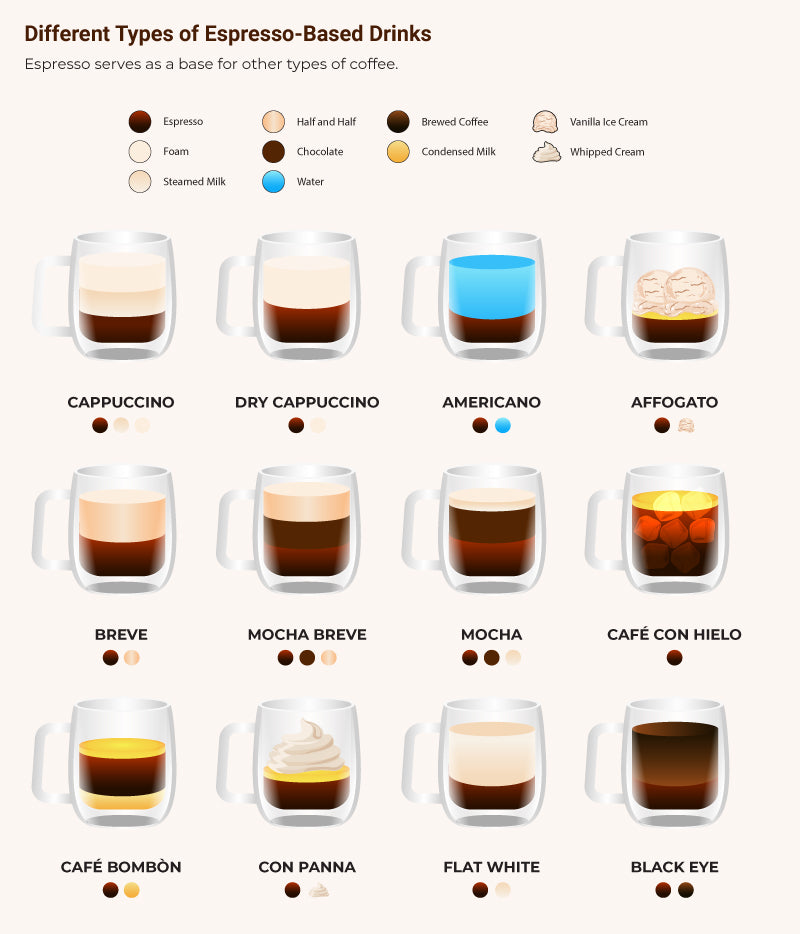
Here’s a quick coffee fact about espresso — it can serve as base for different types of coffee drinks!
- Cappuccinos are made using single or double shots of espresso (30-60 mL) with frothed milk. The ratio of milk foam, liquid milk, and coffee is 1:1:1.
- Lattes are made using two shots of espresso mixed with milk at a 1:3 ratio (120 mL).
- Macchiatos traditionally use just one shot of espresso — about 30 mL with a small amount of foam on top. Macchiato means ”mark” in Italian, from when baristas used to mark different shots.
- Cortados contain a single shot of espresso with an equal amount of milk and some foam (60 mL).
- Flat Whites are made using one or two shots of espresso (30-60 mL) mixed with microfoam.
- There’s also an espresso-based drink called Dirty Coffee. It consists of 4 oz to 6 oz of cold milk with one shot of espresso.
Why is It Called Dirty Coffee?
Dirty Coffee is made by pouring espresso over cold milk. The drink is named Dirty Coffee because of the way espresso “stains” the cold milk as the liquids slowly mix together.
Related: How To Make Espresso Coffee
What is the Most Expensive Coffee in the World?

In Thailand, elephants are fed coffee beans to create Black Ivory Coffee, which can cost up to $1,500 per pound, making it the most expensive coffee in the world. It’s also considered the rarest coffee in the world, the industry having produced only 500 pounds in 2023 [55].
In Indonesia, the Kopi Luwak (a small jungle cat) is fed green coffee beans. The beans are then collected from their excrement. Digestive enzymes in the Kopi Luwak's digestive system are said to give the coffee a unique flavor.
Kopi Luwak is the second most expensive coffee in the world, with a pound costing anywhere from $45 for coffee beans collected from farm-raised civets to $600 for coffee beans collected from the wild.
What is the Most Loved Coffee in the World?

The most loved coffee bean in the world is arabica, and this variety makes up 56.7% of the world’s coffee production. Industry forecast shows we’ll produce around 99.9 million 60-kg bags of arabica coffee in 2024/2025 [71].

Espresso-based specialty coffee is on the rise, and we love it so much that our consumption jumped by 10% in the past week alone [22]. More than half of Americans (57%) enjoyed at least a cup of specialty coffee in the past week, and this has increased by 7.5% compared to the past year.
Of the espresso-based drinks, lattes top the list, with 18% of Americans drinking them in the past week. Espresso ranks second (16%), while cappuccinos rank third (14%).
Which is the Healthiest Coffee to Drink?

The healthiest coffee to drink is plain, black coffee. It contains no additives, so no calories, carbohydrates, fat, sugar, and even sodium to worry about [36].
What is the Weirdest Coffee Called?
Two of the weirdest coffee in the world come from animal poop — Kopi Luwak (sometimes called cat poop coffee) and Black Ivory Coffee (also called elephant dung coffee).
What Kind of Coffee is the Sweetest?
The most commonly available, sweetest type of coffee is mocha [34]. It’s a decadent espresso-based drink with sweet chocolate and milk.
What are the Other Types of Caffeine Drinks?
Caffeinated drinks include coffee, true teas (those from the Camellia sinensis plant), yerba mate tea, energy drinks, most sodas, chocolate drinks, and caffeinated water like Phocus Sparkling Water and Water Joe. You can also buy caffeine powder and tablets, which you mix with liquids.
Of note, herbal teas have no caffeine.
What are the most healthy caffeine drinks?
Of those mentioned above, the healthiest caffeinated drinks are black coffee and tea, especially if they contain no additives like creamers and sweeteners. Caffeinated water is also a healthier alternative to sodas and energy drinks.
Is Decaffeinated Coffee Healthy?
A quick coffee fun fact on decaf — it’s just as healthy as coffee with caffeine! Decaf coffee actually offers the same health benefits as caffeinated coffee, but they also differ in many ways [44].
Although decaf still contains around 2 mg of caffeine, it’s not as energizing as regular coffee. Decaf also won’t make you feel as alert and focused or boost your mood, benefits that you get from caffeine [44].
What are the Benefits of Decaf Coffee?
Decaf is best for people who are sensitive to caffeine or those who want to limit their caffeine intake. Although it has less caffeine, it can still provide the same health benefits as regular coffee.
Who is Coffee No 1 in the World?
Starbucks is the number one coffee worldwide based on revenues. In 2023, Starbucks' revenues reached $36 billion. It’s 2.4 times higher than Keurig Dr Pepper’s $14.81 billion revenue in 2023, the second coffee brand on our list. Nestle’s Nescafe lands third place with a 2023 revenue of $11.6 billion.
Using Google Search, we made a list of the most frequently mentioned coffee brands. We then gathered publicly available data on their 2023 revenue and ranked them from highest to lowest. Please note that we didn’t include those brands we couldn’t find any data on.
While we made every effort to ensure our data’s accuracy, we’re also aware that the information we gathered may not be fully up to date and figures may vary. For the most current and accurate information, we recommend visiting the brand’s website.

Which Brand of Coffee is the Best in the US?
Starbucks is the best coffee brand in the US, with nearly half (48.1%) of American adults saying it is their favorite brand. Dunkin and Folgers land second and third places with 44.8% and 29.4%, respectively [74].

Who Sells the Most Coffee in US?
Starbucks sells the most coffee in the US, generating $31.6 billion in sales in 2023. Starbucks’ sales is 2.7 times bigger than its closest competitor, Dunkin’s $11.9 billion. Dutch Bros Coffee ranked third with $1.4 billion [86].

What are 5 Interesting Facts About Caffeine You Might Not Know?
Now, let’s talk about some fun facts about caffeine. We’ve listed a few general facts about caffeine that we feel might interest you.
- Growing practices, plant species, genetics, storage conditions, roasting degree, and brewing method all influence how much caffeine the coffee tree produces.
- Caffeine increases with light and medium roasts, but levels drop with dark roasts [5].
- About 85% of people in the US consume 165 mg of caffeine daily. Folks over 50 consume more, with an average of 226 mg [59].
- The stimulating component of chocolate (Theobroma cacao), called theobromine, is the molecular mirror image of caffeine. It's stimulating like caffeine but less potent overall.
- Smoking makes the body process caffeine up to 50% faster [96].
How Much Caffeine in Coffee?
Depending on how it's made, a cup of coffee can have 65 mg to 120 mg of caffeine. The global average is about 95 mg caffeine per standard 12 oz cup of arabica coffee.

What’s the Safe Amount of Caffeine Per Day?
The FDA recommends that we consume no more than 400 mg of caffeine per day [85]. But for some people, this amount can cause anxiety. Taking more than 200 mg of caffeine in one sitting can also trigger side effects [52].
How Much Caffeine is Too Much?
Consuming more than 400 mg of caffeine in a day can lead to overconsumption. Caffeine also becomes toxic at a dose of 1.2 grams, and over 10 to 14 grams could be fatal. This usually occurs from taking caffeine pills, not chugging espresso [29].
How Long Does Caffeine Take to Work?
All caffeine will be absorbed by the digestive system after oral consumption within 45 minutes [76]. But you can feel its effects start working in about 15 minutes, with bloodstream levels peaking an hour after consumption [99]. The effects can last for several hours.

How Long Does Caffeine Stay in Your System?
Half of the caffeine you’ve consumed stays in your system six hours after consumption. In some people, it could take up to 10 hours for their systems to completely get rid of the caffeine [99].
Some drugs also change how long caffeine's effects last, extending effects by using liver enzymes [65].
When Does Caffeine Tolerance Start?
Caffeine tolerance can build up rapidly, taking effect within a single week. The more caffeine you consume, the faster you develop tolerance.
How to Get Caffeine Out of Your System?
The best way to get caffeine out of your system is to simply wait it out. Drinking plenty of fluids, eating fiber-rich foods, and exercising may also help speed up the process. Of course, you also need to stop consuming more caffeinated beverages and foods so they don’t add more caffeine to what’s still in your system.
What Does Caffeine Do to Your Body?
Caffeine has good and bad effects on the body. It’s a stimulant and, at low to moderate doses, can boost brain functions. You feel more energized, alert, awake, and focused [64]. It also helps with weight loss since it acts as an appetite suppressant and metabolism booster [80,89].

However, at high doses, caffeine produces negative effects. It makes you feel jittery, anxious, restless, and dizzy. It could also trigger headaches, a fast heart rate, and higher-than-normal blood pressure. Caffeine increases gastric acid levels, which can upset your stomach or worsen your heartburn symptoms [80].
Of note, genetic factors appear to influence caffeine's effects and may be inherited from one generation to the next [21].
Can Caffeine Make You Tired?
Yes, caffeine can actually make you feel more tired when it starts wearing off, and adenosine has something to do with it.
Adenosine is a type of brain chemical that makes us feel sleepy. The more sleep we lose, the more adenosine the body produces. Now, caffeine prevents adenosine from binding to its receptors. With no receptors to bind to, we feel more energized, awake, and alert. But as the effects of caffeine wear off, the rush of adenosine binding to the receptors makes us feel tired and sleepy [88].
What are the Caffeine Side Effects to Watch Out for?
Some of the caffeine side effects to watch out for include:
- Jitteriness and shakiness
- Increased anxiety
- Very fast heartbeat and palpitations
- Nausea and vomiting
- Headaches
- Increased sweating
- Cardiac arrest (at very high doses)
Is Coffee Actually Healthy for You?
It’s a mix of both, but in general, coffee is healthy for most people. We’ll discuss these coffee facts below.
Is Coffee Healthy or Unhealthy?
Low to moderate consumption (no more than 400 mg of caffeine) is generally safe and healthy for most adults. However, consuming more than the recommended daily limit can produce side effects and may even worsen some health conditions.
What Do Scientists Say About Coffee?
Attitudes towards coffee have flip-flopped over the years. Today, science supports the opinion that coffee is a health beverage — when used in moderation.
A study conducted in Spain showed that when folks stopped drinking coffee after being regular consumers, their health declined [67].
Why is Coffee Good or Bad?
Coffee is a major source of dietary antioxidants. Green coffee, in particular, contains over 1000 antioxidants.
Research has shown coffee contains many bioactive and beneficial compounds:
- Polyphenols: Polyphenols have been implicated in preventing heart disease, diabetes, and cancer while showing potential neuroprotective properties, treatment of COVID-19, and improved fertility [54].
- Chlorogenic Acids: Also a huge factor in flavor, chlorogenic acids have antiviral, antibacterial, anticancer, and anti-inflammatory effects while reducing the risk of cardiovascular diseases, type 2 diabetes, and Alzheimer’s [77].
- Cafestol: Cafestol may help prevent cancer, inflammation, and diabetes [72].
- Trigonelline: Making up 1% to 3% of dry weight of coffee, trigonelline has neuroprotective and antidiabetic effects [4].
- Melanoidins: Melanoidins have been studied for antimicrobial and anticancer properties alongside effects on inflammation and hypertension [63].
- Hydrocinnamic Acids: Hydroxycinnamic acids may be very beneficial to people with Parkinson's disease [56].
While it depends on many factors like the type of bean, where it was grown, and how it was roasted and prepared, the nutrients one cup of coffee contains are roughly [8]:
- Magnesium: 7 mg (2% of the DV)
- Potassium: 115 mg (3% of the DV)
- Niacin (B3): 0.5 mg (3% of the DV)
- Riboflavin (B2): 0.2 mg (11% of the DV)
- Total Calories: 2–5
A cup of coffee also typically has around 62 mg to 120 mg of caffeine. While caffeine has its own health benefits, it can trigger side effects at very high doses.
Does Coffee Have Fiber?
Yes, coffee contains a small amount of fiber, with each 100 mL having around 0.47 g to 0.75 g of fiber [26]. It’s definitely not enough to meet the recommended dietary fiber intake of 25 g to 30 g daily [42]. But if you’re drinking four cups of coffee daily, then you’d be consuming around 5.8 g of fiber daily, each 8-oz cup having an average fiber content of 1.45 g. This makes you 21% closer to the recommended dietary fiber intake.
What are the 10 Benefits of Coffee?
Here are 10 health benefits of coffee:
- Alertness: Coffee enhances mental performance but can also cause insomnia [27].
- Pain: Caffeine enhances the effect of some painkillers [9].
- Inflammation: Rats given coffee showed marked reductions in inflammatory markers (not found with decaf).
- Microbiome: Coffee is associated with the growth of beneficial gut microbes [79].
- Type 2 Diabetes: Researchers note a ”substantially lower risk” of type two diabetes with a daily coffee habit [95].
- Heart Disease: Some studies show a lower risk of hypertension and heart disease in people who drink coffee every day [58].
- Stroke: Some studies suggest drinking coffee could prevent strokes [50].
- Cancer Risk: Studies show a reduced risk of colon and liver cancer in people who drink a lot of coffee [84,53].
- Degenerative Neurological Conditions: Coffee consumption is correlated with a reduced risk of developing Parkinson's and Alzheimer's disease [41,28].
- Overall Mortality: Frequent coffee consumption is associated with longer life [92].

What are 3 Positive Effects of Coffee on Our Mental Health?
Below are three positive effects of coffee on our mental health:
- Depression: Coffee may reduce depression risk and improve mood [47].
- Anxiety: At low doses, the caffeine in coffee may help reduce anxiety and boost mood [73].
- Suicide Risk: Moderate coffee consumption has also been associated with lower suicide risk [52].
What Does Coffee Do to Your Body in the Short Term?
The short-term effects of coffee include increased awareness, concentration, energy, and focus. It may also cause a spike in heart rate and blood pressure, but this depends on the caffeine level and your tolerance.
Why is Coffee So Good for You in the Long Term?
Based on the benefits above, regular coffee consumption decreases the risk of developing chronic health diseases, including but not limited to heart disease, stroke, and cancer. People who drink coffee also live longer than non-coffee drinkers.
What Happens If I Drink Coffee Everyday?
Drinking coffee every day should be okay for most people. However, the body builds a tolerance to caffeine over time. You’d need to consume higher amounts of coffee just to feel the same effects.
Is It Okay to Drink Coffee When Sick?
Drinking coffee when you’re sick with the common cold should be okay. One study found that coffee (even decaf!) improved alertness and psychomotor performance in people with colds, bringing them to the same level as healthy people [81].
However, if you’re dealing with more serious health issues, especially if there’s diarrhea or vomiting involved, then it’s best to avoid coffee for a while since it can increase the risk of dehydration.
Is It Bad to Drink Coffee on an Empty Stomach?
Most people don’t have any issues drinking coffee on an empty stomach, and there’s little evidence to suggest that it can cause harm. However, coffee can increase stomach acid and may worsen the symptoms of stomach ulcers and heartburn [45].
Is Coffee Good for Your Kidneys and Liver?
Yes. Studies show coffee may be good for both the kidneys and the liver. Drinking a cup of coffee a day may lower the risk of acute kidney injury (AKI) by 15%, compared to non-coffee drinkers. The risk further decreases by 22% to 23% in those who drink two to three cups a day. Even those who have comorbidities like hypertension, obesity, and diabetes have an 11% lower risk of developing AKI than non-coffee drinkers [93].
Drinking more than two cups of coffee a day is also good for people with preexisting liver disease. According to a study, it can reduce the risk of fibrosis and cirrhosis. It also lowers cancer and mortality risk [97].
What Kind of Coffee is Good for Liver and Kidneys?
Unsweetened black coffee still remains the best coffee for the liver and the kidneys [82]. Avoid coffee with additives containing high sugar and calorie content. These include sweet syrups and creamers and milk with high phosphorus, calcium, and potassium levels.
Does Coffee Raise Blood Pressure?
Yes, coffee causes a spike in blood pressure in the short term, but with consistent consumption, this spike becomes less significant [13].
Does Coffee Raise Cholesterol?
Yes. However, the increase in total and LDL cholesterols was seen in unfiltered coffee consumption. Consumption of filtered coffee only resulted in a minute increase in serum cholesterol [46].
Unfiltered coffee contains diterpenes like kahweol and cafestol, which can increase the cholesterol and triglyceride levels in the serum [72]. Diterpenes may also be present in filtered coffees, but the filter removes most of them.
Does Coffee Make You Gain Weight?
Unsweetened black coffee won’t make you gain weight, especially since it contains only around 2 calories and 0 fat and sugar [33]. However, the extra calories, fat, and sugar from coffee additives like sugar and cream can contribute to weight gain.
Drinking coffee before bedtime affects sleep. Sleep loss, in turn, promotes weight gain [69].
Is Coffee Good for Weight Loss
Coffee has been shown to support weight loss through thermogenesis [30]. Coffee is also known to suppress appetite and boost metabolism.
Is Coffee Anti-Aging?
Studies show coffee helps slow down biological aging. According to a study, the compounds found in coffee (but not caffeine) increase telomere length. Telomeres are found at the ends of our chromosomes, and these shorten as we age. Regular coffee consumption increases telomere length by 40.3 base pairs. It also slows down cellular aging by 2.6 years [94].
What Happens When You Drink Too Much Caffeine While Pregnant?
Drinking an average of half a cup of coffee daily (around 50 mg of caffeine) while pregnant can increase the risk of delivering small-for-gestational-age babies, compared to pregnant women who abstained from caffeine. According to the study, the babies were 66 g (2.3 ounces) lighter than non-coffee drinkers [60].
Caffeine also causes vasoconstriction of the uterus and placenta, which could limit the baby’s blood supply and affect growth and development.
Early exposure to caffeine also increases the baby’s risk of developing diabetes, obesity, and heart disease later on in life.
Of note, according to the American College of Obstetrics and Gynecology (ACOG), pregnant women should limit their caffeine intake to no more than 200 mg a day [40].
Does Coffee Dehydrate You?
Coffee is a diuretic and makes you pee, but moderate use isn't a dehydration risk [49].
Does Coffee Make You Short?
No. There is no scientific evidence that shows coffee or caffeine negatively impacts or stunts one’s growth [14].
This misconception came from the belief that coffee causes osteoporosis. This is a bone disease wherein we lose bone mineral density and mass. Not only do the bones grow weaker and more fragile, but we also lose an inch or more of our height. However, there is no link between coffee and osteoporosis.
How Does Coffee Affect Blood Test?
The compounds found in coffee, including caffeine, can affect the results of your blood test. Coffee is a diuretic and may increase urine frequency. The dehydrating effect can mess up your lab test result [100].
Studies did show that drinking coffee an hour before a blood test statistically increased the results of the lipid and blood panels. However, the changes were not clinically significant [15,6].
What are the Downsides of Coffee?

Coffee may have a lot of benefits, but it also has some disadvantages as well.
- Coffee disrupts sleep and can cause insomnia, especially if you drink coffee six to eight hours before sleep.
- Overconsumption triggers adverse side effects.
- Coffee can be addictive and cause tolerance or dependence over time.
- Coffee can stain teeth.
- Low-quality coffee beans can also contain nasty compounds that are harmful to our health.
- At a dose of 1.2 g, caffeine can be toxic; and at a dose of 10 g to 14 g, it can be fatal.
Caffeine toxicity is more commonly caused by consuming highly caffeinated products like energy drinks and caffeine pills and rarely occurs from drinking coffee or espresso. The caffeine content of energy drinks usually ranges from 80 mg to 150 mg per 8 ounce, while caffeine pills typically have around 100 mg to 200 mg per pill [3,75]. It’s easier to overconsume these products than coffee.
For coffee to be toxic, you’d need to drink around 12 cups of coffee in a short period of time (or around 100 to 140 cups for a fatal dose!), assuming each cup has about 100 mg of caffeine.
What is the Nasty Stuff in Coffee?
Coffee may also contain nasty stuff that can harm one's health. Some of these include:
- Acrylamide: A compound formed when coffee beans are roasted, acrylamide is toxic to the neurons. It’s also carcinogenic and may increase cancer risk [62].
- Ochratoxin A: Found in coffee beans and other food products, ochratoxin A is a mycotoxin produced by a fungus. It is toxic to the kidneys and may also increase kidney cancer risk [12].
- Herbicides and Pesticides: Coffee plants are often sprayed with pesticides and herbicides to control pest and weed infestation. While the processing method gets rid of these chemicals, some poorly processed beans can retain harmful levels of these residues.
This is why choosing quality beans like Cafely’s is very important. Not only does the brand use traditional growing methods but the beans are also organically grown.
Who Should Not Drink Coffee?

Again, coffee is safe and healthy for most people. But if you have the following conditions, you may want to avoid caffeine or at least monitor your intake [18].
- Pregnant and Breastfeeding Women: Caffeine can negatively affect the baby, so try to avoid it if you’re pregnant or breastfeeding or at least limit intake to no more than 200 mg a day.
- Anxiety and Bipolar Disorder: Caffeine can worsen anxiety and mania symptoms, especially when consumed in high amounts.
- Bleeding Disorder: Caffeine might interfere with clotting and worsen bleeding disorders.
- Hypertension: Coffee might cause a spike in blood pressure in people with hypertension. However, this effect is not as noticeable in regular coffee drinkers.
- Heart Disease: Regular coffee consumption and smoking can increase the mortality risk in people with heart disease.
- Diabetes: Caffeine might reduce your cell’s sensitivity to glucose and cause a spike in blood sugar levels.
- Irritable Bowel Syndrome: In high amounts, caffeine could worsen the symptoms of irritable bowel syndrome, including diarrhea.
- Glaucoma: Caffeine might cause an increase in intraocular pressure in people with glaucoma, an effect that could last for about 1.5 hours.
- Bladder Issues: Caffeine can negatively affect bladder control in people with bladder issues, potentially increasing urinary frequency and urgency.
- Bone Issues: The caffeine in coffee can contribute to calcium loss and weaken bones.
FAQs and Everything You Love About Coffee
Got coffee information overload? Let’s break down some of the fun coffee facts worth knowing!
1. Why is Coffee Called Coffee?
Coffee came from the Arabic word “qahwa.” Although this translates to coffee, it also means “wine.”
2. What is a Coffee Trivia That Many May Not Know?
Coffee is really not a type of bean but a seed of a fruit-bearing plant that belongs to the Coffea genus.
3. What are Some Interesting Facts About Coffee Beans?
We’re most familiar with the two most popular coffee beans in the world — arabica and robusta. However, there are around 100 coffee species.
4. What are Some Coffee History Facts You Should Know?
The US was originally a tea-drinking country, but the country shifted to coffee after the Boston Tea Party. When Britain increased tea taxes the Americas, the colonists revolted by throwing tea to the sea. They also boycotted tea and switched to coffee.
5. How Old is Coffee Drinking?
We’ve been enjoying coffee for nearly 12 centuries (1,174 years). However, we originally chewed the beans before brewing them as a drink.
6. What are Three Good Things About Coffee?
Below are three good facts about coffee:
- It’s a stimulant that can help boost energy, focus, concentration, mood, and even physical performance.
- It’s rich in beneficial compounds like antioxidants and can help reduce the risk of many chronic diseases — from inflammation and pain to heart disease, stroke, cancer, and diabetes.
- People who drink coffee tend to live longer than those who don’t.
7. What is a Health Fact About Coffee That Might Surprise You?
Coffee, but not caffeine, can help slow down cellular aging. A study found that coffee can actually increase the length of our telomeres. These are basically the protective caps of our chromosomes which shorten as we age.
8. What is a Fun Fact About Coffee?
We have webcams today thanks to researchers at the University of Cambridge who wanted to know if there was coffee in the Trojan Room, their main computer lab. They set up a video camera, pointed it at the coffee pot, and connected it to their network so they could easily monitor the coffee pot without leaving their stations [48].
9. What is a Surprising Fact About Coffee?
Instant coffee was invented because Brazil had a surplus of coffee. World War I disrupted the coffee industry, leaving Brazil with a national surplus. The Brazilian Coffee Institute collaborated with Nestle in developing instant coffee, which became extremely popular during the Second World War.
10. Why Coffee is So Special?
We have a very deep relationship with coffee. More than just a beverage, coffee has shaped culture, politics, and economics. Religious bias has also nearly made coffee a banned drink in Europe, with some Christians calling it Satan’s Drink.
11. Which Country Drinks the Most Coffee?
Owing to its large population, the US drinks the most coffee, having consumed around 26.3 million bags of coffee in 2023.
12. What State Drinks the Most Coffee?
Also owing to its large population, California drinks the most coffee, consuming roughly around 245.5 million kilos of coffee yearly.
13. What are 5 Facts About Caffeine?
Below are five interesting facts about caffeine:
- A cup of coffee usually contains anywhere from 65 mg to 120 mg of caffeine.
- Caffeine’s effects peak an hour after consumption, but it can sometimes take the body 10 hours to fully flush it out.
- Consuming 400 mg of caffeine is okay. But at 1.2 g, it can be toxic to humans and fatal at 10 g to 14 g.
- Caffeine is a type of stimulant drug that we can become dependent on and addicted to.
- We can build caffeine tolerance in as little as a week.
14. What is the Healthiest Coffee?
All types of coffee offer health benefits, but the healthiest is plain, black coffee with no additives.
15. What are the Disadvantages of Coffee?
Coffee, in general, offers many health benefits, but consuming more than the recommended daily limit of 400 mg of caffeine can cause side effects. Overconsumption can make you jittery, restless, and anxious. People with chronic health conditions exercise caution when consuming highly caffeinated coffee.
References
- 10 Steps from Seed to Cup. (2015). National Coffee Association of U.S.A.
- Alexander, B. N. (2022). Why Is Coffee Called a Cup of Joe? Reader’s Digest.
- Alsunni, A. A. (2015). Energy Drink Consumption: Beneficial and Adverse Health Effects. International Journal of Health Sciences, 9(4), 468–474.
- Ashihara, H. (2015). Chapter 3 - Plant Biochemistry: Trigonelline Biosynthesis in Coffea arabica and Coffea canephora. In Coffee in Health and Disease Prevention (pp. 19–28). Academic Press.
- Awwad, S., Issa, R., Alnsour, L., Albals, D., & Al-Momani, I. (2021). Quantification of Caffeine and Chlorogenic Acid in Green and Roasted Coffee Samples Using HPLC-DAD and Evaluation of the Effect of Degree of Roasting on Their Levels. Molecules (Basel, Switzerland), 26(24), 7502.
- Benozzi, S. F., Unger, G., Campion, A., Milano, P. G., & Pennacchiotti, G. L. (2023). Coffee intake one hour prior to phlebotomy produces no clinically significant changes in routine biochemical test results. Biochemia Medica, 33(2), 020705.
- Benveniste, A. (2022). How ‘Java’ Became Coffee’s Nickname and a Programming Language. The New York Times.
- Beverages, coffee, brewed, espresso, restaurant-prepared. (2019). U. S. Department of Agriculture.
- Boppana, S. H., Peterson, M., Du, A., Gabriel, R. A., & Kutikuppala, L. V. S. (2022). Caffeine: What Is Its Role in Pain Medicine? Cureus, 14(6), e25603.
- Brand, A. (2024). Coffee breaks boost productivity by 23%, study finds. HR Strategy News.
- Buchholz, K. (2023). America Runs on . . . Bottled Water. Statista.
- Bui-Klimke, T. R., & Wu, F. (2015). Ochratoxin A and Human Health Risk: A Review of the Evidence. Critical Reviews in Food Science and Nutrition, 55(13), 1860–1869.
- Caffeine: How does it affect blood pressure? (2014). Mayo Clinic.
- Can Coffee Really Stunt Your Growth? (2020). Harvard Health.
- Cheung, R. J., Gupta, E. K., & Ito, M. K. (2005). Acute Coffee Ingestion Does Not Affect LDL Cholesterol Level. Annals of Pharmacotherapy, 39(7–8), 1209–1213.
- Coffee, 1400-1800. (2021). University of California (UC Santa Cruz).
- Coffee farmers. (2020). Fairtrade.
- COFFEE: Overview, Uses, Side Effects, Precautions, Interactions, Dosing and Reviews. (2019). WebMD.
- Coffee: the drink that changed the world. (2009). UC Irvine News.
- Coffee Timeline. (2020). Vanderbilt University.
- Cornelis, M. C., Byrne, E. M., Esko, T., Nalls, M. A., Ganna, A., Paynter, N., Monda, K. L., Amin, N., Fischer, K., Renstrom, F., Ngwa, J. S., Huikari, V., Cavadino, A., Nolte, I. M., Teumer, A., Yu, K., Marques-Vidal, P., Rawal, R., Manichaikul, A., . . . Chasman, D. I. (2015). Genome-wide meta-analysis identifies six novel loci associated with habitual coffee consumption. Molecular Psychiatry, 20(5), 647–656.
- Daily coffee consumption at 20-year high, up nearly 40%. (2024). National Coffee Association of U.S.A.
- Daily Survey: Coffee. (2022). YouGov.
- December 2023 Coffee Report and Outlook. (2023). International Coffee Organization (ICO).
- DeSilver, D. (2013). Chart of the Week: Coffee and tea around the world. Pew Research Center.
- Díaz-Rubio, M. E., & Saura-Calixto, F. (2007). Dietary Fiber in Brewed Coffee. Journal of Agricultural and Food Chemistry, 55(5), 1999–2003.
- Dong, X., Li, S., Sun, J., Li, Y., & Zhang, D. (2020). Association of Coffee, Decaffeinated Coffee and Caffeine Intake from Coffee with Cognitive Performance in Older Adults: National Health and Nutrition Examination Survey (NHANES) 2011–2014. Nutrients, 12(840), 1–17.
- Eskelinen, M. H., & Kivipelto, M. (2010). Caffeine as a Protective Factor in Dementia and Alzheimer’s Disease. Journal of Alzheimer’s Disease, 20(Suppl 1), S167–S174.
- Evans, J., Richards, J. R., & Battisti, A. S. (2024). Caffeine. StatPearls [Internet].
- Four cups of coffee a day associated with modest loss of body fat. (2020). Harvard T.H. Chan School of Public Health.
- Garcia-Freites, S., Welfle, A., Lea-Langton, A., Gilbert, P., & Thornley, P. (2019). The potential of coffee stems gasification to provide bioenergy for coffee farms: a case study in the Colombian coffee sector. Biomass Conversion and Biorefinery, 10(4), 1137–1152.
- Gorman, J. (2015). The Caffeinated Lives of Bees. The New York Times.
- Health Benefits of Black Coffee. (2020). WebMD.
- Herbst, C. (2024). Your Ultimate Guide to Different Types of Coffee. Taste of Home.
- Here’s to Pope Clement VIII. (2020). Roman Catholic Diocese of Harrisburg.
- [Historical Record]: Black Coffee. (2019). U. S. Department of Agriculture.
- History of Viennese coffee house culture. (2013). City of Vienna.
- Hot Drinks Market Size, Share & Trends Analysis Report By Product (Coffee, Tea), By Region (North America, Europe, APAC, CSA, MEA), And Segment Forecasts, 2019 - 2025. (2019). In Grand View Research (GVR-3-68038-452-9).
- Hou, C., Zeng, Y., Chen, W., Han, X., Yang, H., Ying, Z., Hu, Y., Sun, Y., Qu, Y., Fang, F., & Song, H. (2022). Medical conditions associated with coffee consumption: Disease-trajectory and comorbidity network analyses of a prospective cohort study in UK Biobank. The American Journal of Clinical Nutrition, 116(3), 730–740.
- How much coffee can I drink while I’m pregnant? (2020). American College of Obstetricians and Gynecologists (ACOG).
- Hu, G., Bidel, S., Jousilahti, P., Antikainen, R., & Tuomilehto, J. (2007). Coffee and tea consumption and the risk of Parkinson’s disease. Movement Disorders, 22(15), 2242–2248.
- Increasing Fiber Intake. (2024). UCSF Health.
- Is Coffee Bad for Kids? (2023). Johns Hopkins All Children’s Hospital.
- Is decaf coffee safe? (2020). National Coffee Association of U.S.A.
- Is It OK To Drink Coffee on an Empty Stomach? (2021). Cleveland Clinic.
- Jee, S. H., He, J., Appel, L. J., Whelton, P. K., Suh, I., & Klag, M. J. (2001). Coffee Consumption and Serum Lipids: A Meta-Analysis of Randomized Controlled Clinical Trials. American Journal of Epidemiology, 153(4), 353–362.
- Kang, D., Kim, Y., & Je, Y. (2018). Non-alcoholic beverage consumption and risk of depression: epidemiological evidence from observational studies. European Journal of Clinical Nutrition, 72(11), 1506–1516.
- Kesby, R. (2012). How the world’s first webcam made a coffee pot famous. BBC News.
- Killer, S. C., Blannin, A. K., & Jeukendrup, A. E. (2014). No Evidence of Dehydration with Moderate Daily Coffee Intake: A Counterbalanced Cross-Over Study in a Free-Living Population. PLoS ONE, 9(1), e84154.
- Kim, B., Nam, Y., Kim, J., Choi, H., & Won, C. (2012). Coffee Consumption and Stroke Risk: A Meta-analysis of Epidemiologic Studies. Korean Journal of Family Medicine, 33(6), 356–365.
- Koehler, J. (2017). In WWI Trenches, Instant Coffee Gave Troops A Much-Needed Boost. The Salt: NPR.
- Lara, D. R. (2010). Caffeine, Mental Health, and Psychiatric Disorders. Journal of Alzheimer’s Disease, 20(Suppl 1), S239–S248.
- Larsson, S. C., & Wolk, A. (2007). Coffee Consumption and Risk of Liver Cancer: A Meta-Analysis. Gastroenterology, 132(5), 1740–1745.
- LIczbiński, P., & Bukowska, B. (2022). Tea and coffee polyphenols and their biological properties based on the latest in vitro investigations. Industrial Crops and Products, 175, 114265.
- Maron, D. F. (2023). $1,500 for “naturally refined” coffee? Here’s what that phrase really means. Animals.
- Medvedeva, M., Kitsilovskaya, N., Stroylova, Y., Sevostyanova, I., Saboury, A. A., & Muronetz, V. (2022). Hydroxycinnamic Acid Derivatives from Coffee Extracts Prevent Amyloid Transformation of Alpha-Synuclein. Biomedicines, 10(9), 2255.
- Megersa, H. J. (n.d.). History of Coffee [Jimma University].
- Mendoza, M. F., Sulague, R. M., Posas-Mendoza, T., & Lavie, C. J. (2023). Impact of Coffee Consumption on Cardiovascular Health. Ochsner Journal, 23(2), 152–158.
- Mitchell, D. C., Knight, C. A., Hockenberry, J., Teplansky, R., & Hartman, T. J. (2014). Beverage caffeine intakes in the U.S. Food and Chemical Toxicology, 63, 136–142.
- Moderate daily caffeine intake during pregnancy may lead to smaller birth size. (2021). National Institutes of Health (NIH).
- Mohamed Zein, Z. (2018). The story of coffee in the Middle East. In Middle East Institute, National University of Singapore. MEI Kaleidoscope.
- Mojska, H., & Gielecińska, I. (2013). Studies of acrylamide level in coffee and coffee substitutes: influence of raw material and manufacturing conditions. Roczniki Panstwowego Zakladu Higieny, 64(3), 173–181.
- Moreira, A. S. P., Nunes, F. M., Domingues, M. R., & Coimbra, M. A. (2012). Coffee melanoidins: structures, mechanisms of formation and potential health impacts. Food & Function, 3(9), 903–915.
- National Library of Medicine. (2016). Caffeine. MedlinePlus.
- Nehlig, A. (2018). Interindividual Differences in Caffeine Metabolism and Factors Driving Caffeine Consumption. Pharmacological Reviews, 70(2), 384–411.
- Oldest cat ever. (2005). Guinness World Records.
- Ortolá, R., Carballo-Casla, A., García-Esquinas, E., Lopez-Garcia, E., Banegas, J. R., & Rodríguez-Artalejo, F. (2020). Health Decline Is Associated with Reports of No Coffee Consumption Years After Reporting Coffee Consumption Among Older Adults in Spain. The Journal of Nutrition, 150(7), 1916–1923.
- Panhuysen, S., & De Vries, F. (2023). Coffee Barometer 2023.
- Papatriantafyllou, E., Efthymiou, D., Zoumbaneas, E., Popescu, C. A., & Vassilopoulou, E. (2022). Sleep Deprivation: Effects on Weight Loss and Weight Loss Maintenance. Nutrients, 14(8), 1549.
- Pressat Team. (2014). Here are the professions that glug the most coffee. Journalists are officially the biggest addicts. Pressat.
- Production, Supply and Distribution Online (PS&D). (2024). United States Department of Agriculture, Foreign Agricultural Service.
- Ren, Y., Wang, C., Xu, J., & Wang, S. (2019). Cafestol and Kahweol: A Review on Their Bioactivities and Pharmacological Properties. International Journal of Molecular Sciences, 20(17), 4238.
- Richards, G., & Smith, A. (2015). Caffeine consumption and self-assessed stress, anxiety, and depression in secondary school children. Journal of Psychopharmacology, 29(12), 1236–1247.
- Ridder, M. (2024). Favorite coffee brands among consumers in the U.S. in 2023. Statista.
- Robinson, K. M. (2021). Caffeine Pills: What to Know. WebMD.
- Rodak, K., Kokot, I., & Kratz, E. M. (2021). Caffeine as a Factor Influencing the Functioning of the Human Body—Friend or Foe? Nutrients, 13(9), 3088.
- Rojas-González, A., Figueroa-Hernández, C. Y., González-Rios, O., Suárez-Quiroz, M. L., González-Amaro, R. M., Hernández-Estrada, Z. J., & Rayas-Duarte, P. (2022). Coffee Chlorogenic Acids Incorporation for Bioactivity Enhancement of Foods: A Review. Molecules (Basel, Switzerland), 27(11), 3400.
- Román, I. (2022). 6 Ways Coffee Helped Transform the World. HISTORY.
- Rosa, F., Marigliano, B., Mannucci, S., Candelli, M., Savioli, G., Merra, G., Gabrielli, M., Gasbarrini, A., Franceschi, F., & Piccioni, A. (2024). Coffee and Microbiota: A Narrative Review. Current Issues in Molecular Biology, 46(1), 896–908.
- Schubert, M. M., Irwin, C., Seay, R. F., Clarke, H. E., Allegro, D., & Desbrow, B. (2017). Caffeine, coffee, and appetite control: a review. International Journal of Food Sciences and Nutrition, 68(8), 901–912.
- Shoemaker, S. (2020). Can You Drink Coffee When You’re Sick? Healthline.
- Shusterman, B. (2021). Top 5 healthy drinks for people with kidney disease. American Kidney Fund.
- Siles, P., Cerdán, C. R., & Staver, C. (2022). Smallholder Coffee in the Global Economy—A Framework to Explore Transformation Alternatives of Traditional Agroforestry for Greater Economic, Ecological, and Livelihood Viability. Frontiers in Sustainable Food Systems, 6.
- Sinha, R., Cross, A. J., Daniel, C. R., Graubard, B. I., Wu, J. W., Hollenbeck, A. R., Gunter, M. J., Park, Y., & Freedman, N. D. (2012). Caffeinated and decaffeinated coffee and tea intakes and risk of colorectal cancer in a large prospective study. The American Journal of Clinical Nutrition, 96(2), 374–381.
- Spilling the Beans: How Much Caffeine is Too Much? (2023). US Food and Drug Administration (FDA).
- Statista Research Department. (2024a). Leading coffee shop and cafe chain sales in the U.S. 2023. Statista.
- Statista Research Department. (2024b). Per-capita volume sales in the coffee market worldwide by country 2023. Statista.
- Summer, J., & Singh, A. (2024). Why Does Coffee Make You Tired? Sleep Foundation.
- Tabrizi, R., Saneei, P., Lankarani, K. B., Akbari, M., Kolahdooz, F., Esmaillzadeh, A., Nadi-Ravandi, S., Mazoochi, M., & Asemi, Z. (2019). The effects of caffeine intake on weight loss: a systematic review and dos-response meta-analysis of randomized controlled trials. Critical Reviews in Food Science and Nutrition, 59(16), 2688–2696.
- The History of Coffee. (2015). National Coffee Association of U.S.A.
- The Knowledge Academy. (2023). How To Be A Coffee Aficionado- A Complete Career Guide.
- Thomas, D. R., & Hodges, I. D. (2020). Dietary Research on Coffee: Improving Adjustment for Confounding. Current Developments in Nutrition, 4, nzz142.
- Tommerdahl, K. L., Hu, E. A., Selvin, E., Steffen, L. M., Coresh, J., Grams, M. E., Bjornstad, P., Rebholz, C. M., & Parikh, C. R. (2022). Coffee Consumption May Mitigate the Risk for Acute Kidney Injury: Results From the Atherosclerosis Risk in Communities Study. Kidney International Reports, 7(7), 1665–1672.
- Tucker, L. A. (2017). Caffeine consumption and telomere length in men and women of the National Health and Nutrition Examination Survey (NHANES). Nutrition & Metabolism, 14(10).
- Van Dam, R. M., & Hu, F. B. (2005). Coffee Consumption and Risk of Type 2 Diabetes. JAMA, 294(1), 97–104.
- Van Dam, R. M., Hu, F. B., & Willett, W. C. (2020). Coffee, Caffeine, and Health. The New England Journal of Medicine, 383(4), 369–378.
- Wadhawan, M., & Anand, A. C. (2016). Coffee and Liver Disease. Journal of Clinical and Experimental Hepatology, 6(1), 40–46.
- What is Coffee? (2015). National Coffee Association of U.S.A.
- What to Know About How Long Caffeine Lasts. (2021). WebMD.
- What You Should Know About Fasting Before a Blood Test. (2022). Cleveland Clinic.
- Yaqub, M. (2024). How Many People Drink Coffee in the World [2024 Update]. BusinessDasher.
- Zainuri, N., Paramartha, D. N. A., Fatinah, A., Nofrida, R., Rahayu, N., Anggraini, I. M. D., & Utama, Q. D. (2023). The Chemical Characteristics of Arabica and Robusta Green Coffee Beans. BIOTROPIA, 30(3), 318–328.
